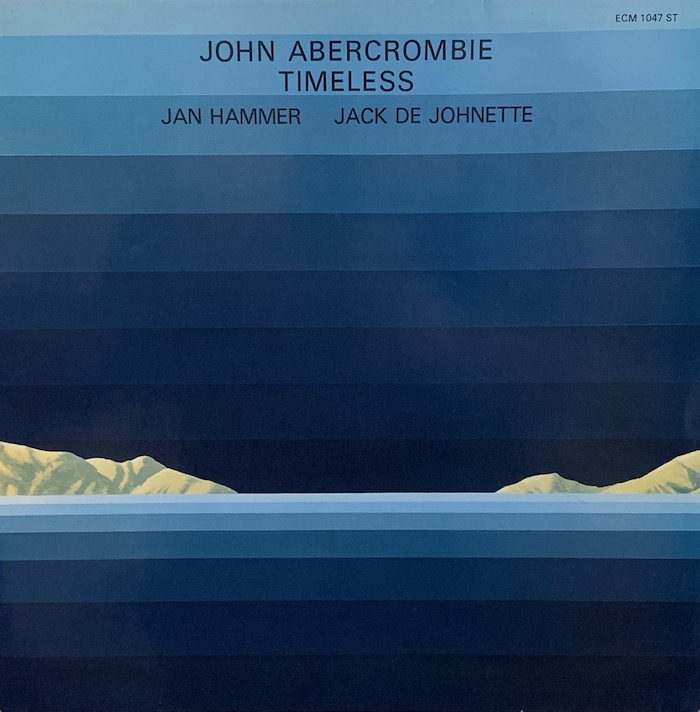
‘Changeless’ and ‘endless’ were the defining terms of our last post on virtuoso pianist Keith Jarrett. Continuing this theme, we follow with ‘Timeless’, the beautiful final track on guitarist John Abercrombie’s 1975 album of the same name, which like Jarrett’s Changeless, was also released on ECM and featured Jack DeJohnette on drums.
‘Timeless’ was Abercrombie’s debut album and marked the beginning of a long and successful recording career playing on more than fifty sessions for ECM. On this album he joined forces with drummer Jack DeJohnette and pianist Jan Hammer who played organ, piano and synthesizer. All three musicians were already seasoned fusion players – Jan Hammer, a roommate of Abercrombie’s in the 60s, was a member of Mahavishnu Orchestra whilst both Abercrombie and DeJohnette had featured on Mahavishnu drummer Billy Cobham’s famous albums Total Eclipse (1974) and Crosswinds (1974). Abercrombie had also played on DeJohnette’s Sorcery that same year.
Interestingly, ‘Timeless’ opens with the 12 minute long track ‘Lungs’, an intense fusion workout written by Hammer. The album closes with ‘Timeless’, a composition by Abercrombie which mirrors ‘Lungs’ in the fact that it is also 12 minutes long. Intentional or a happy coincidence, it makes the listener feel as if they’ve come full circle.
The track begins with the trio slowly building a rich soundscape – Abercrombie solos over deep synth chords from Hammer whilst DeJohnette adds washes of cymbals in the background like a painter. At around four minutes, Abercrombie introduces a moody motif which forms the foundation of the rest of the track. The solo which follows highlights the sensitive and understated playing style Abercrombie became known for. Inspired by the musical styles of pianist Bill Evans and guitarist Jim Hall, Abercrombie preferred to blend into the background rather than be centre stage, often joking that he wanted to feel like a sideman in his own bands. The band build in intensity and at the eight minute mark, Hammer takes a soaring solo over the top of DeJohnette’s rich and textural playing. Throughout the track, all three band members weave in and out of each other creating music which could be described as proto-ambient.
It’s worth noting that Brian Eno, widely regarded as the founding father of ambient music, had only just begun to explore ‘ambient’ music that same year with his album Discreet Music. The term ‘ambient’ was later coined by Eno on his album Ambient 1 (Music For Airports) (1978). Whilst Eno is credited for defining and developing this new genre, it’s interesting that artists such as Abercrombie were creating music prior to this which could easily be described as ambient. As with many musical developments, jazz was often ahead of the curve. What’s striking is how spacious ‘Timeless’ sounds, a result of the high quality production values and dynamic range that ECM recordings became known for. Listening to a clean copy of this record on a decent system is a revelation.
Like many of my musical discoveries, it was through hip hop that I discovered this album. The ambient and moody soundscape of ‘Timeless’ has been a draw to hip hop and electronic music producers in search of samples. Having been sampled numerous times, the most inventive uses I’ve heard are on Slum Village’s ‘Reunion’ produced by Black Milk and Four Tet’s ‘I’m On Fire (Part 1)’ & ‘I’m On Fire (Part 2)’. The first flips a later passage of Abercrombie’s composition into a shuffling boom bap head-nodder whilst the latter loops up the ambient guitar, pitches it up and couples it with a garage drum pattern to create a beautifully addictive piece of dance music.
Timeless is a fantastic album and one of my favourites in the ECM catalogue. Sporting a beautifully minimal cover design characteristic of many ECM releases, the album is a high quality example of 70s jazz fusion, blending both acoustic and electronic sounds and flirting with ambient textures. Abercrombie unfortunately died back in 2017 but he leaves behind an impressive musical legacy. In his own words, “I’d like people to perceive me as having a direct connection to the history of jazz guitar, while expanding some musical boundaries.” Listening to this album, I think it’s safe to say he succeeded.
Find more from Abercrombie in our ‘Six String Stars’ playlist or delve into our ‘In A Tranquil Mood’ playlist on Spotify for more mellow and calming jazz.
If you enjoyed this post and want to stay updated, make sure to subscribe to our Spotify playlist and follow us on Instagram and Twitter!
